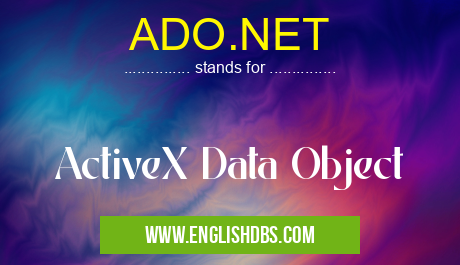What does ADO.NET mean in SOFTWARE
ADO.NET, or ActiveX Data Object.NET, is a Microsoft technology designed to provide access to relational and non-relational databases through the use of .NET Framework components. ADO.NET enables developers to work with multiple data types, including text files, XML documents and common database formats like SQL Server, Oracle Database and Access Database. By using ADO.NET, developers can easily connect with databases and access stored data by building queries that are executed against the database schema. In addition to its capabilities for connecting with traditional databases, it also supports working with popular web-based data sources such as OData (Open Data Protocol) and RESTful services such as Amazon Web Services (AWS).

ADO.NET meaning in Software in Computing
ADO.NET mostly used in an acronym Software in Category Computing that means ActiveX Data Object
Shorthand: ADO.NET,
Full Form: ActiveX Data Object
For more information of "ActiveX Data Object", see the section below.
What is ADO.NET
ADO.NET is a set of .NET Framework classes used to access data stored in relational databases or from other data sources such as XML documents or text files. Its primary purpose is to enable developers building .NET applications to interact with a variety of data sources without needing knowledge about each underlying source type or format. Until the release of Entity Framework (EF) in 2008, ADO.NET was the main component responsible for connecting a .net application with a database server such as Microsoft SQL Server or Oracle Database Express Edition (Oracle XE). Starting from EF onwards though., Microsoft has provided an object-relational mapping system which exploits LINQ technology and allows developers to construct entities directly from their underlying database tables thereby hiding much of the coding needed prior to EF’s introduction using ADO. Net only; this greatly simplified coding considerably reducing development time when compared with same period usage of just ADO .Net alone.
Advantages of Using ADO .Net
ADO .Net offers several advantages that make it useful for developing applications that need real-time access to diverse data sources within the same application codebase. For one, it's platform-independent -- meaning that applications written leveraging ADO .Net can be deployed on any supported operating system regardless of whether it’s Windows , Linux , Mac OS X , iOS , etc.. Additionally, since its foundation lies within the larger managed code framework provided by Visual Studio & MSDN Support Library via x86/x64 hardware support framework 2D/3D Rendering systems.; hence less time is required when debugging issues even though related features may conflict with other subsystems requiring more advanced skillsets at times for complete resolution when dealing with 3rd party software libraries causing integration difficulties
Essential Questions and Answers on ActiveX Data Object in "COMPUTING»SOFTWARE"
What is ADO.NET?
ADO.NET is a set of computer software components that programmers use to access data and data services. It is part of the Microsoft .NET Framework and provides an interface for applications to access data from various sources, such as relational databases, XML files, and other web services. It can be used with any application or programming language that supports the .NET Framework.
What are the differences between ADO and ADO.NET?
ADO operates in a disconnected manner, while ADO.NET has both connected and disconnected architectures. Additionally, ADO works with COM objects and relies on automation, while ADO.NET utilizes classes written in managed code incorporated into the .Net framework. Lastly, the ADO version can’t communicate directly with XML documents, whereas the .Net version can do this easily as it was designed specifically for manipulating XML files That's why it is largely replacing earlier versions of COM-based data access technologies like ActiveX Data Objects (ADO).
What are some advantages of using ADO.NET?
One advantage of using ADO.NET is its ability to connect databases across multiple platforms by making use of different providers, allowing developers greater flexibility when developing applications that require access to multiple databases or web services simultaneously from different platforms. Another advantage is its more efficient management system compared to earlier versions that relied on COM objects or Automation; this means there is less overhead when managing data connections within an application built on .net framework technology like ASP or C#. Finally, since it was designed specifically for manipulating XML files it enables developers to easily work with structured data stored in XML documents within their applications – a feature not present in older versions of COM-based data access technologies like ActiveX Data Objects (ADO).
Is there a downside to using ADO.Net?
The main downside of using ADO.Net would be its relatively slow performance when directly compared to other alternatives such as Entity Framework; however this difference might not be noticeable unless your application requires extensive manipulation of large datasets or complex queries on them frequently during operation time intervals of user interaction with the application UI dashboard/screens/forms etc..
What are some features that stand out about when using an Oracle database through AD0 .net?
When working with an Oracle database through an Ado .net connection one feature that stands out would have to be extensive support for Oracle specific features such as PL/SQL blocks, Bind variables as well as Bulk operations which all help considerably accelerate performance speed compared to traditional database operations especially those involving retrieval & updates scenarios both at individual row & batch levels.
What methods must I implement when creating a custom provider with Ado .net?
The methods which must be implemented by any custom provider created using Ado .net would include some combination depending upon requirements; but typically these would include GetSchemaTable(), ExecuteNonQuery() ,ExecuteScalar(), ExecuteReader() ,BeginTransaction(), CommitTransaction(), RollbackTransaction(), CreateParameter() ,CreateCommand() ,DisposeMetaData() & Close().
What does “Database Independent” mean when referring to Ado .net?
Database independent refers to Ado’s ability for developers so they can switch between different types/versions of databases without necessarily having to make significant modifications at source code level due to API changes thus allowing much faster turnaround times for changes without incurring additional costs associated rearchitecture efforts which at times may prove too costly.
